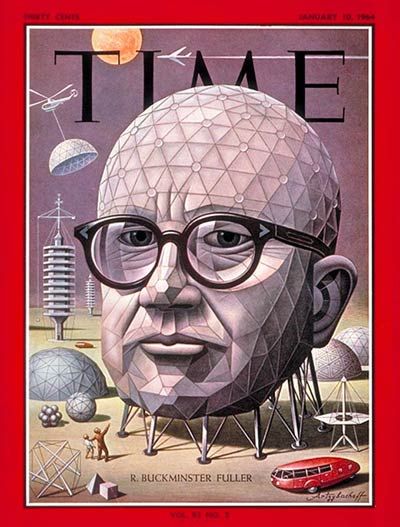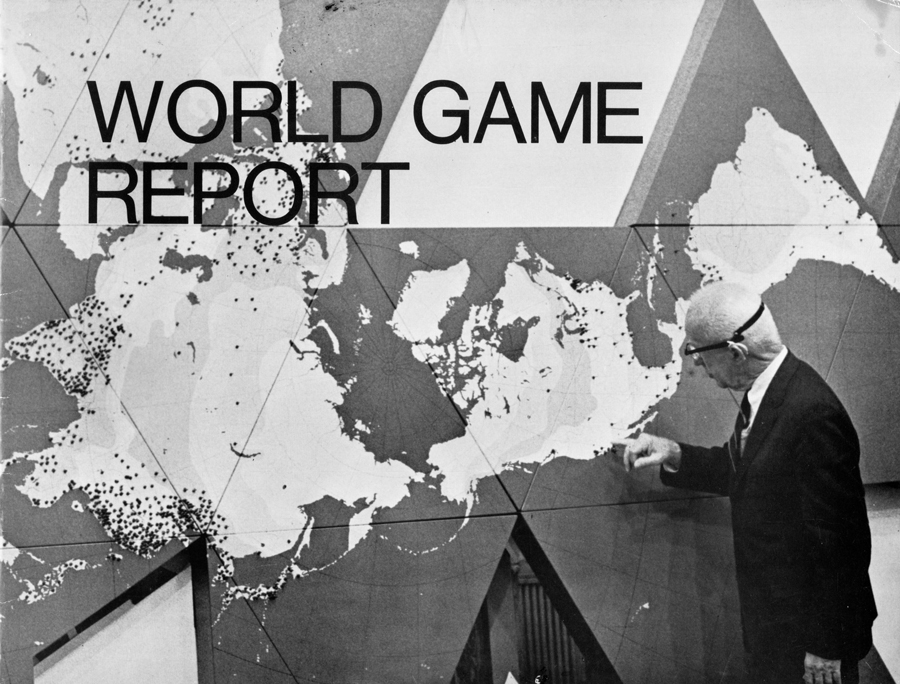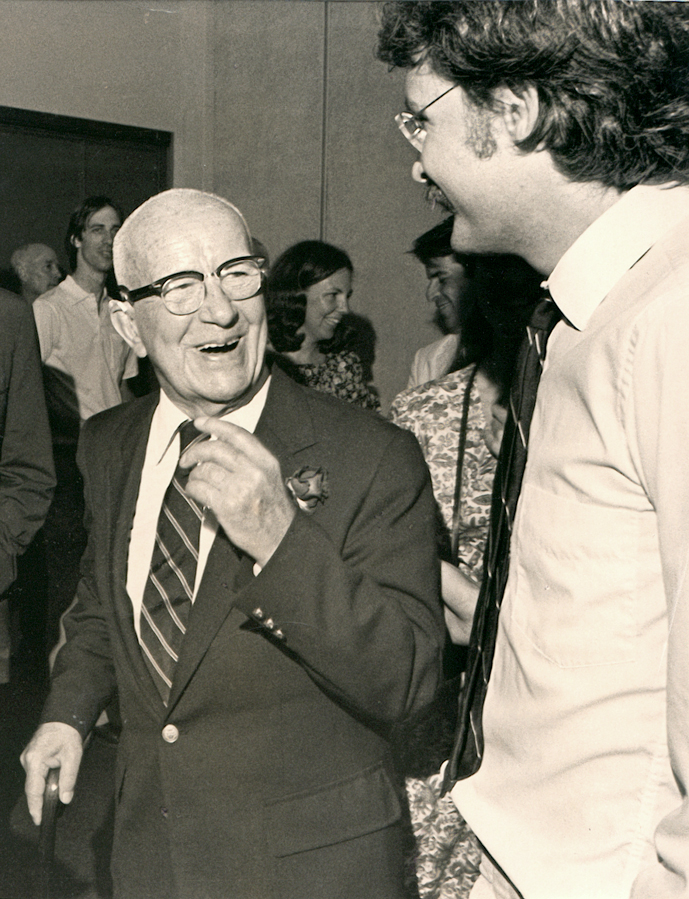BUCKMINSTER FULLER
For those unfamiliar with Buckminster Fuller, the following articles will provide an introduction. The first, by Medard Gabel, is excerpted from Buckminster Fuller, Anthology for the New Millennium, St. Martins Press, 2001 and can be read below.
The second, by Medard Gabel and Jim Walker, is on Buckminster Fuller and leadership. You can read it here.
Buckminster Fuller and the Game of the World
By Medard Gabel
The Encyclopedia of the Future, a 1,115 page two-volume tome first published in 1996, took over five years to produce and featured contributions from over 400 different experts. It covered topics ranging from Abortion to Zion and is considered to be an authoritative source on all matters concerning the rapidly growing field of “futurology,” futurism or futures studies. Featured in the appendix is a survey of professional futurists that asked, “Who was the most influential futurist in the history of the world?”
Buckminster Fuller is listed first. Ahead of such luminaries as H. G. Wells, Isaac Newton, Arnold J. Toynbee and Leonardo da Vinci.
Why? Why was such a distinction bestowed on the inventor of a house that hardly made it past the three-foot model stage, a car that never went into mass production, a mass produced bathroom ensemble that never made it to the masses, a structure for enclosing large spaces, and a bunch of social theories and policies that have been called everything from iconoclastic to naive? Why indeed.
The answer lies in Fuller’s grand perspective, bold synthesis of technology and human values, and his integration of these into a tool for humanity to use in solving its planetary problems. As important as his inventions were in their own right (and as a more balanced presentation than the one above would soon disclose) they pale in comparison to their impact on the world’s imagination of what is possible. When Fuller proposed a housing service industry in the 1920s that would mass produce “housing units”, air deliver them via giant dirigible to any place in the world—and those same housing units would be hung from a central tower that contained all the services needed for the house to be autonomous—Fuller was not just fifty to hundred years ahead of his time, he was lighting a bonfire in the collective imagination of the world (and a firebomb in the straw house of the architectural profession). What Fuller’s original autonomous house did was present a way not only of building a revolutionary house in a revolutionary way, he presented a way of looking at building, housing, shelter and architecture in a way that swept them all away in a grand vision of housing as a basic human need that all humans have (not just the client in traditional architectural circles) and which was a global, not local or personal problem that only the rich could afford to address while the rest of humanity had to make do. Fuller’s contribution went further: his methodology for addressing the housing problem was generalizable. You could, as did he, apply it to transportation, energy, education, pollution, accounting, governance and a wealth of additional social problems.
The core of this approach was a concern with the whole: the whole Earth, the entire history of the planet, all of humanity—both those living now and those yet to be born. His approach, as he would later codify it, was
- Comprehensive, starting from the whole system and working back to the special case, dealing with all facets of a problem, including the larger system the problem was a part of;
- Anticipatory, in that it sought to recognize the threats coming down the pike before they arrived full blown on an unsuspecting or ill-prepared society, as well as to deal with the way things were going to be when the solution was going to be implemented, not the way things were in the present;
- A design strategy, in contradistinction to a political, or let’s pass-a-law-and-change-human-behavior approach, it sought to change the larger system of which the specific problem was a part;
- A science-based methodology that used the latest advances of science to benefit humanity.
His “Comprehensive Anticipatory Design Science” was at least as much a perspective on the problems of the world as it was a methodology for tackling those problems. When applied to contemporary problems, whether those of Fuller’s day or the twenty-first century, it leads to strikingly fresh insights and solutions. It was also the perspective that led to the World Game.
In the 1960’s Buckminster Fuller proposed a “great logistics game” and “world peace game” (later shortened to simply, the “World Game”) that was intended to be a tool that would facilitate a comprehensive, anticipatory, design science approach to the problems of the world. The use of “world” in the title obviously refers to Fuller’s global perspective and his contention that we now need a systems approach that deals with the world as a whole, and not a piece meal approach that tackles our problems in what he called a “local focus hocus pocus” manner. The entire world is now the relevant unit of analysis, not the city, state or nation. We are, in Fuller’s words, onboard Spaceship Earth, and the illogic of 200 nation state admirals all trying to steer the spaceship in different directions is made clear through the metaphor—as well in Fuller’s more caustic assessment of nation states as “blood clots” in the world’s global metabolism.
The logic for the use of the word “game” in the title is even more instructive. It says a lot about Fuller’s approach to governance and social problem solving. Obviously intended as a very serious tool, Fuller choose to call his vision a “game” because he wanted it seen as something that was accessible to everyone, not just the elite few in the power structure who thought they were running the show. In this sense, it was one of Fuller’s more profoundly subversive visions. Fuller wanted a tool that would be accessible to everyone, whose findings would be widely disseminated to the masses through a free press, and which would, through this groundswell of public vetting and acceptance of solutions to society’s problems, ultimately force the political process to move in the direction that the values, imagination and problem solving skills of those playing the democratically open world game dictated. It was a view of the political process that some might think naïve, if they only saw the world for what it was when Fuller was proposing his idea (the 1960s)—minus personal computers and the Internet. The playing field was not to be so much as leveled, or expanded, but the good ‘ol boy political process was to subverted out of existence by a process that brings Thomas Jefferson into the twentieth century.
In order to have this kind of power, the game needed to have the kind of information and tools for manipulating that information that empowers. It needed a comprehensive database that would provide the players of the world game with better data than their politically elected or appointed counterparts. They needed an inventory of the world’s vital statistics—where everything was and in what quantities and qualities, from minerals to manufactured goods and services, to humans and their unmet needs as well as capabilities. They also needed an information source that monitored the current state of the world, bringing vital news into the “game room” live. Non of this existed when Fuller began talking about a world game. And then something funny happened on the way to the twenty-first century: CNN, personal computers, CD ROMS, the Internet and worldwide web, supercomputer power on personal computers and reams of data about the world, its resources, problems and potential solutions started to bubble to the surface and transform the world and the way we communicate, do business, research and govern.
The World Game that Fuller envisioned was to be a place where individuals or teams of people came and competed, or cooperated, to
“Make the world work,
for 100% of humanity,
in the shortest possible time,
through spontaneous cooperation,
without ecological offense
or the disadvantage of anyone.”
Making the world work for 100% of humanity reflects Fuller’s global perspective as well as his values. We are not here just to make ourselves rich, famous or top consumer of the day or decade, or here just for the 3% living in our part of the world, we’re here for all of humanity. The “spontaneous cooperation” is instructive in light of the previous discussion on the choice of the word “game” as part of the title for this activity. The phase does not read, “Make the world work for 100% of humanity through a central government, or through enforced coercion by a strong military” but through a cooperation that arises from a fundamental transparency of society and its needs. If everyone knows what the situation is, has a clear vision of what should be and what needs to be done, we cooperate to get it done—as we do as a society in times of emergency.
In Fuller’s vision of a world peace game, participants would come to play from around the world, irrespective of their political ideology or local concerns. One model of how it could work had players focused on a problem, like world food availability or hunger, for a certain time period, say a week. The team or individual that demonstrated how, using current technology and known resources, hunger could be eliminated in ten years, would “win”. The team that could show how it could be done in a shorter time, or by using less resources, or costing less, or accomplishing more than one thing at a time, such as providing clean water as well as eliminating malnutrition, would win round 2. Round 3 would be won by an effort that was even “better”. The next week the focus would shift to energy, or health or education. Eventually the focus would return to food. These efforts, as pointed out above, were not intended as academic exercises. Each new strategy that incrementally improved the method for solving a problem was one step closer to implementation in Fuller’s view. The strategies for solving a given problem would become ever more compelling as they demonstrated how all humanity “won”—that the game of the world was not the zero-sum I win/you lose variety, but the total-wealth increasing kind.
© 2001 Medard Gabel






